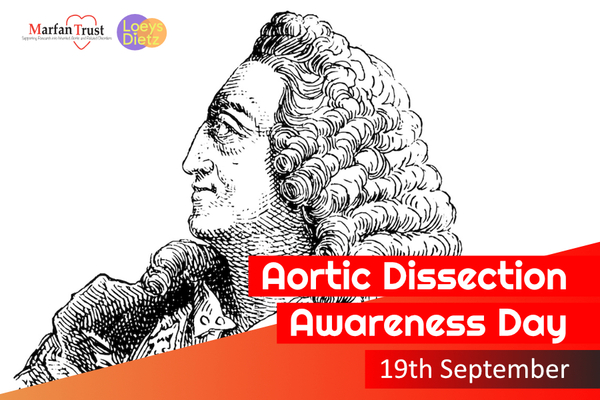Today is a day dedicated to raising life-saving awareness of aortic dissection, still an under-recognised condition, yet one that was first documented centuries ago, in 1760 ...

Aortic dissection was described historically as far back as the time of King George II. Below is an excerpt from a biography of the late King.
Taken from King George II Biography – Facts, Childhood, Family Life & Achievements
“On 25 October 1760 George II, then 76, rose at his normal hour of 6 AM, called as usual for his chocolate, and repaired to the closet-stool. The German valet de chambre heard a noise, memorably described as ‘louder than the royal wind’, and then a groan; he ran in and found the King lying on the floor, having cut his face in falling. Mr Andrews, surgeon of the household, was called and bled his Majesty but in vain, as no sign of life was observed from the time of his fall. At necropsy the next day Dr Nicholls, physician to his late Majesty, found the pericardium distended with a pint of coagulated blood, probably from an orifice in the right ventricle, and a transverse fissure on the inner side of the ascending aorta 3.75 cm long, through which blood had recently passed in its external coat to form a raised ecchymosis, this appearance being interpreted as an incipient aneurysm of the aorta.”
Thankfully, aortic dissection is much better understood in modern times. It is far safer now to be a patient than it was even as recently as two years ago, in 2022. This is thanks to a Patient Toolkit, the impetus for which was the Patient Voice provided by the Aortic Dissection Awareness UK & Ireland charity.
However, patients still remain undiagnosed and below we share the sad story of Jonny.
Jonny bore archetypal traits of Marfan syndrome yet these remained unnoticed, even during a spell in hospital. Had his condition been diagnosed, he would probably have been given an echocardiogram and perhaps his life could have been saved.

Jonny's Story
Jonathan Edwards was a fit and healthy man. He was living a full and lively life. He died suddenly and unexpectedly from an aneurysm. He was 23. It was discovered posthumously that Jonathan - 'Jonny' - had Marfan syndrome. In retrospect the signs and symptoms were there all along, but no one “joined the dots”.
As his relatives say: “Jonny was tall and thin, his rib cage stuck out (pigeon chest), his toes curled, he had stretch marks on his back and he was able to touch his wrist with his thumb. His wing span was longer than his height. Had we, or the doctors, heard of Marfan syndrome, we may have been able to join the dots. Jonny would have been tested, and probably undergone surgery.”
As a child ‘Jonny’ had a bad chest and asthma. At 16 he spent time on the Ear Nose and Throat Ward of his local hospital, recovering from an operation on his ear which antibiotics had failed to clear up. The ward was one that treated Marfan patients, yet Jonny remained undiagnosed during his stay, and his condition hid in plain sight.
Jonathan’s mother, Elizabeth has said: “I DON'T EVER WANT ANOTHER MOTHER TO FEEL LIKE I DO AND IF I COULD SAVE ONE LIFE I WOULD GIVE MY RIGHT ARM."









